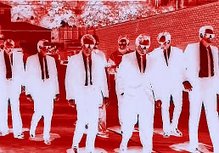Monday, October 10, 2011
You Notice The Hook
You read over an Academic Paper Format. You read down the outline. You notice the five part Introduction. You notice The Hook is the first part. You read, "-attention getter (Why should the reader care?)" You imagine a fish hook binding pages together instead of a paperclip or staple. You imagine invisible magician's fishing line. You imagine the line unreeled from inside a reader's eye and knotted into the eyelet of the hook. You imagine everything with words with hooks. You imagine strings dangling from eyes, knotting themselves around the reading hooks automatically when you want to know what something says. You imagine this is how reading works. You imagine a grocery store. You imagine the magazine rack. You imagine a meager greeting card selection. You imagine old women crying over touching sympathy cards. You imagine their tears welling and flowing down their eye-strings toward the hook. You imagine the hook rusting after enough tears. You imagine everyone knows the best cards all have rusted hooks. You remember how blood rusts. You imagine finding a perfect sympathy card and wanting other people to read the card but not being able to cry. You imagine cutting your finger on the hook when you can not bring yourself to cry. You realize how blood and tears often appear as a package. You hope your blood-rust hook works. You hope your finger's hook-cut is enough to turn shoppers into readers. You hope not-crying does not make them stop caring. You return to the Academic Paper Format. You read the last section of the outline. You notice the seven part Discussion. You read the last part. You read, "Provide a brief conclusion."
Subscribe to:
Post Comments (Atom)


No comments:
Post a Comment